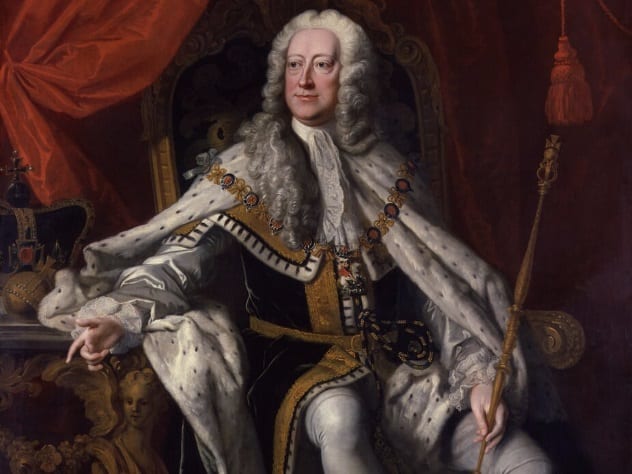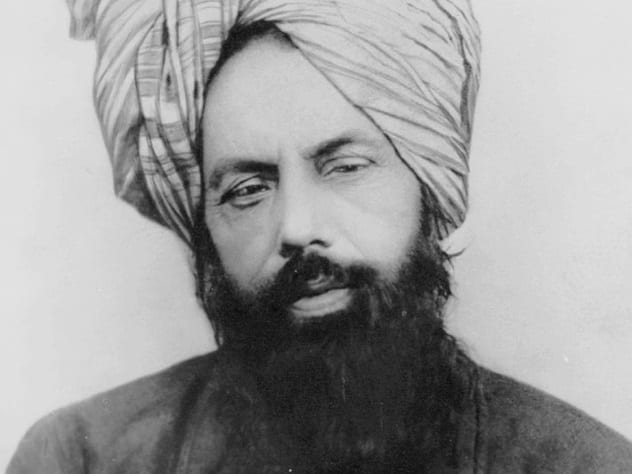 Our World
Our World  Our World
Our World  Weird Stuff
Weird Stuff 10 Fascinating Facts You Might Not Know About Snow
 Miscellaneous
Miscellaneous Top 10 Things Crypto Was Supposed to Change & What Actually Did
 History
History 10 Huge Historical Events That Happened on Christmas Eve
 Music
Music 10 Surprising Origin Stories of Your Favorite Holiday Songs
 History
History 10 Less Than Jolly Events That Occurred on December 25
 Weird Stuff
Weird Stuff 10 Funny Ways That Researchers Overthink Christmas
 Politics
Politics 10 Political Scandals That Sent Crowds Into the Streets
 Weird Stuff
Weird Stuff Ten Bizarre Facts About The Doge Meme
 Our World
Our World 10 Ways Your Christmas Tree Is More Lit Than You Think
 Our World
Our World 10 Archaeological Discoveries of 2025 That Refined History
 Weird Stuff
Weird Stuff 10 Fascinating Facts You Might Not Know About Snow
 Miscellaneous
Miscellaneous Top 10 Things Crypto Was Supposed to Change & What Actually Did
Who's Behind Listverse?

Jamie Frater
Head Editor
Jamie founded Listverse due to an insatiable desire to share fascinating, obscure, and bizarre facts. He has been a guest speaker on numerous national radio and television stations and is a five time published author.
More About Us History
History 10 Huge Historical Events That Happened on Christmas Eve
 Music
Music 10 Surprising Origin Stories of Your Favorite Holiday Songs
 History
History 10 Less Than Jolly Events That Occurred on December 25
 Weird Stuff
Weird Stuff 10 Funny Ways That Researchers Overthink Christmas
 Politics
Politics 10 Political Scandals That Sent Crowds Into the Streets
 Weird Stuff
Weird Stuff Ten Bizarre Facts About The Doge Meme
 Our World
Our World 10 Ways Your Christmas Tree Is More Lit Than You Think
10 People Who Died On The Toilet (That Aren’t Elvis)
Everyone knows that Elvis died on the toilet, and there have been many celebrity bathroom-related deaths since. Dying on the pot is not just a modern phenomenon, however.
While it may seem an ignominious end to a life, there have been plenty of people throughout history who have had to suffer the indignity of being found dead on the toilet. And, although you may not be able to cheat fate entirely, if you have enemies, you may find it wise to check your toilet bowl for danger before sitting down to relieve yourself. Here are ten people from history who died on the toilet.
10 Duke Jing Of Jin

Duke Jing was the ruler of the province of Jin, one of the strongest states in China, from 599 BC until his untimely death in 581 BC. He is said to have had a nightmare, following which his personal shaman predicted his untimely death before he had time to “eat the new grain.”
The duke, being the superstitious sort, immediately fell ill and called for a doctor. Further dreams told him that the cause of his illness (personified in the form of two boys) would be found somewhere between his diaphragm and his heart. When the doctor arrived, he confirmed the diagnosis from the dream.
Jing, in an effort to beat his curse, ate the new grain before it was fully ripe. Then, feeling fine, he executed his shaman. For a while, the duke believed that he had cheated the curse, but the unripe grain began to ferment in his stomach/ Hurrying to the toilet, he fell into the privy pit and drowned in the slurry below.[1]
9 King Edmund II Of England

King Edmund II (nicknamed Edmund Ironside) was king of England for just seven months in 1016. He raised an army to fend off invasions by the Danish invader Canute (aka Cnut the Great). However, after a siege in London, Edmund was finally defeated. At the Treaty of Alney, Canute allowed Edmund to retain lands in Wessex in return for a peace agreement.
Not long after that, Edmund passed away. Some say he died of natural causes. However, Henry of Huntingdon’s account of Edmund’s death states that when Edmund answered the call of nature, he was stabbed twice from below by an assassin concealed in the pit beneath the toilet seat. The assassin left the knife, which had ruptured Edmund’s bowel, protruding from the king’s rear end while he made his escape.[2]
Painful.
8 Godfrey IV, Duke Of Lower Lorraine

In 1076, Duke Godfrey, or Godfrey the Hunchback as he was known, made a trip to the toilet “because of his natural need.” Godfrey was a military man who waged war on behalf of Emperor Henry IV of Germany, so it is fair to say he had enemies.
Normally a careful man, he could not have foreseen that when he attended to this natural need, he would be attacked with a “cruel pointed weapon” from below just as he began to stand up again. It is believed that one of the guards surrounding the house had been paid to stand beneath the toilet pit with a spear or long sword.
The duke is said to have lingered for a week before finally dying of his wounds, though it is probably fair to say that he thought twice before attending to any natural needs after that.[3]
7 King George II

George II acceded to the British throne in 1727, though he was German. He was not a popular king. When he was only a prince, he quarreled with his father and most of his advisers, and he is even said to have hated his own son. He disliked Britain and spent so much time back in his native Germany that his subjects called him “the king who wasn’t there.” He did love his wife, though. He never remarried after she died, and after his own death, he was buried next to his wife, and the sides of their coffins were removed so that their remains could “mingle.”[4]
Despite his curmudgeonly nature, however, George II lived to a ripe old age. Finally, not long before his 77th birthday, the king, while paying a visit to the little king’s room, died quietly of an aortic dissection sitting on his commode, or “close stool,” as it was termed (“stool” being the operative word).
6 Catherine The Great

While death on a toilet is often seen as a somewhat degrading way to die, Catherine the Great would probably have been glad for people to believe she had died that way, because it was far less demeaning than some of the rumors that were flying around Saint Petersburg after her death.
Having married into the Russian royal family in 1745, Catherine had a fairly rocky start to her marriage. For eight years, she failed to conceive a child, and it was rumored that her husband was unable, or unwilling, to consummate their marriage. So, in 1754, when she finally gave birth to a child, the court gossip suggested that the father was, in fact, a Russian soldier with whom she had developed a recent friendship. Catherine herself appeared to encourage the rumors, though whether they were true is still up for debate. However, it is all but certain that none of her three subsequent children were fathered by her husband.
Catherine was certainly ruthless, conspiring to overthrow her husband just six months after he became tsar, forcing him to abdicate and leaving her the sole ruler of Russia. It is unclear whether Catherine was complicit in her husband’s murder a short time later.
Catherine was famous for taking lovers during her reign, showering them with gifts of land and servants. Perhaps it was this reputation that fueled the rumors about the manner of her death. Her enemies at the court, in an attempt to damage her reputation, claimed that she had died engaging in a sex act with a horse. That’ll do it.
The other assertion made at the time was that she died from a stroke on the toilet. That’s much more mundane and much more possible. Officially, she died in her bed a day after suffering the stroke.[5]
5 Mirza Ghulam Ahmad

Mirza Ghulam Ahmad founded the Islamic religious movement Ahmadiyyah in India. Born in 1835, Ghulam Ahmad claimed to hear revelations from God, and in 1889, he declared that God had entitled him to receive an oath of allegiance from his followers.
He soon had a small group of devoted disciples, and his following steadily increased, along with opposition from traditional Islamists. Ghulam Ahmad claimed that he was a mahdi (“savior”), a reincarnation of the Prophet Muhammad and also Jesus Christ and the Hindu god Krishna, all rolled into one, which is impressive.
At the end of 1907, Ghulam Ahmad claimed to have received several revelations informing him of his imminent death. In May 1908, the day before he died, he wrote his final tract, entitled “A Message of Reconciliation.” Ghulam Ahmad had been suffering from dysentery for some time and died in the bathroom at the home of his friend and doctor of complications arising from acute diarrhea. However, this is disputed by some of his followers because the cause of death did not match those of his visions. And also because diarrhea is rather an ignoble death for a prophet.[6]
4 Uesugi Kenshin

Uesugi Kenshin was a Japanese warlord until his death in 1578. He was famous for his military prowess and his bitter rivalry with Takeda Shingen, who he met in battle at least five times. Though the two were rivals, it seems they came to respect each other as adversaries, and Kenshin was given a highly prized sword by Shingen. The two eventually became allies and friends.
In later years, after the death of Takeda Shingen, Uesugi Kenshin took up arms against Oda Nobunaga, the most powerful warlord in Japan. Though he secured a number of tactical victories against his opponent, his health was declining rapidly, and in a death not at all befitting a hero, Uesugi Kenshin suffered a stroke while using the potty and died a few days later.
Unsatisfied with such a lackluster end to the war, many people, including Oda Nobunaga, attempted to rewrite the events with stories of hidden ninjas, but his death seems to have been of entirely natural causes.[7]
3 Edward II

King Edward II was murdered at Berkeley Castle in 1327, in a manner that can only be described as eye-watering.
While a young man, Edward was thought to have had intimate relationships with a male friend at the court. On being discovered, his father banished the lover “on account of the undue intimacy which the young Lord Edward had adopted towards him.” The lover was later murdered, leading Edward to wage several wars in retaliation.[8]
Edward’s wife, Isabella, unhappy at her husband’s behavior, plotted against him with her lover. Edward was captured and forced to abdicate his throne. It is said, though it cannot be proved, that Edward was murdered in the bathroom of Berkeley Castle by having a red-hot poker inserted into his anus, as a punishment for his homosexuality, and that his screams could be heard miles away.
2 Wenceslas III Of Bohemia

King Wenceslas III acceded to the throne of Bohemia in 1305. He was already king of Hungary and aspired to the Polish throne, although, so as not to seem greedy, he did give up his right to be king of Austria. At the time of his accession, he was only 15 years old.
The last king of Bohemia, Wenceslas was murdered in 1306, the last in the male line of the powerful Premyslid dynasty. He is often described as well-educated, though a little too much inclined to drinking and partying rather than ruling his sizeable kingdom. His rival, Charles Robert of Anjou, under the protection of the pope, maneuvered to become the Hungarian king, and the Hungarian crown was eventually ceded to him.
In 1306, Wenceslas arrived in the town of Olomouc, where he resided in the deanery. It has been claimed that Ladislaus the Short, the king of Poland, fearing that Wenceslas was plotting to overthrow him, sent assassins to murder him. Wenceslas was said to be sitting in his garderobe (a room with a toilet which emptied into the lake below) when the assassins found him and stabbed him to death. He was 16.[9]
1 King Eglon

The story of King Eglon is one of the stranger tales to be found in the Bible. Although many biblical characters can be traced through history, little is known of King Eglon. He has been described in the Talmud as being the grandson of the Moab king, Balak, who tried to destroy the Israelites by luring them into adultery. Well, if you have to go . . .
According to the Old Testament, the Israelites had been sold into slavery under King Eglon, so God sent Ehud to deliver them. He paid Eglon tribute and later visited the king in his “private chamber,” hiding a large double-edged sword beneath his robes. King Eglon, who was a rather heavy man, rose “from his seat,” whereupon Ehud stabbed him with the sword, ramming it into his belly until the hilt of the sword disappeared beneath the folds of his flesh.
Ehud then escaped, and Eglon’s servants, observing a certain odor emanating from the king’s private chamber, assumed that the king was occupied and left him in peace. While they waited patiently for the king to finish his business, Ehud led his men into battle and slaughtered King Eglon’s army while they were still hanging around waiting for the king to finish up so that they could get their orders.[10]
Ward Hazell is a writer who travels, and an occasional travel writer.
Read more bathroom-related stories on 10 Most Influential Things To Have Happened In A Bathroom and 10 Bizarre Toilet Tales From Around the World.








